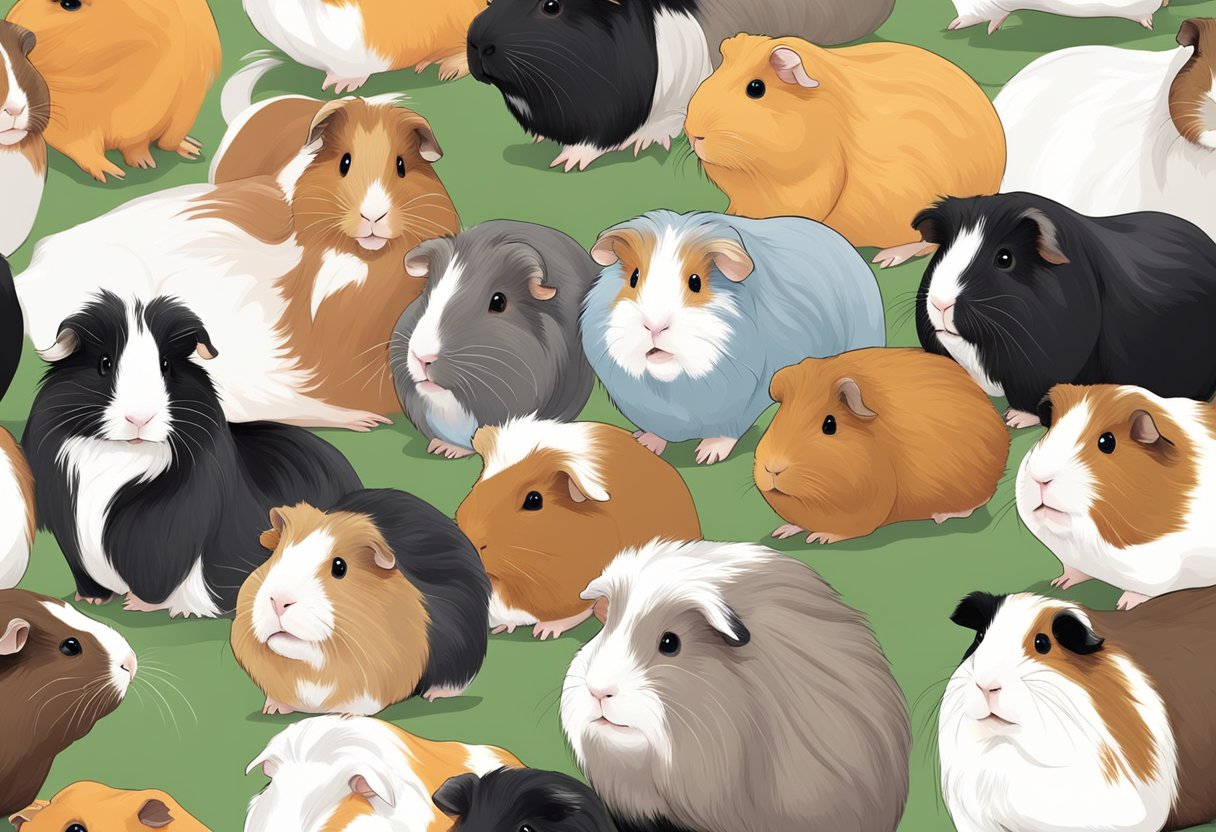Types Of Guinea Pigs
Guinea pigs are popular pets for families around the world. These domesticated rodents are native to South America and come in a variety of breeds, each with its own unique characteristics. From their coat types and grooming needs to their behavior and temperament, there is a lot to learn about these adorable creatures.
One of the most interesting aspects of guinea pigs is the variety of breeds available. Some of the most popular breeds include the American, Abyssinian, Peruvian, and Sheltie/Silkie. Each breed has its own unique coat type and grooming requirements, so it’s important to do your research before bringing one home. Additionally, understanding the behavior and temperament of each breed can help you choose the perfect pet for your family.
Caring for a guinea pig involves more than just providing food and water. These animals require regular grooming, exercise, and socialization to stay healthy and happy. Understanding the physical characteristics and breed standards of your guinea pig can help you provide the best possible care. With the right knowledge and care, guinea pigs can make wonderful pets for families of all ages.
Key Takeaways
- Guinea pigs come in a variety of breeds, each with its own unique characteristics.
- Understanding a guinea pig’s behavior and temperament can help you choose the perfect pet for your family.
- Proper care involves regular grooming, exercise, and socialization to keep your guinea pig healthy and happy.
Popular Guinea Pig Breeds

There are many different types of guinea pig breeds, but some are more popular than others. Here are a few of the most common breeds that you might encounter:
American Guinea Pig
The American guinea pig is one of the oldest and most well-known breeds. They have short, smooth coats that come in a variety of colors. These guinea pigs are known for their friendly and laid-back personalities, which makes them a great choice for first-time owners. They are also relatively easy to care for, and can often be found in pet stores.
Abyssinian Guinea Pig
The Abyssinian guinea pig is another popular breed that is known for its unique coat. These guinea pigs have short, messy hair that sticks up in all directions, giving them a distinctive appearance. They are also very affectionate and gentle, which makes them a great choice for families with children. However, their coats require more maintenance than some other breeds, so owners will need to be prepared to brush and groom them regularly.
Peruvian Guinea Pig
The Peruvian guinea pig is a long-haired breed that is known for its flowing locks. These guinea pigs have hair that can grow up to 20 inches long, and their coats require a lot of maintenance to keep them looking their best. However, they are also very friendly and social animals, and they love to interact with their owners. If you’re looking for a guinea pig that will be a constant companion, the Peruvian might be the right choice for you.
Teddy Guinea Pig
The Teddy guinea pig is a popular breed that is known for its short, fuzzy coat. These guinea pigs have a round, teddy-bear-like appearance that makes them very appealing to many people. They come in a variety of colors, and their coats are relatively easy to care for. However, they can be a bit more high-maintenance when it comes to grooming than some other short-haired breeds.
Overall, these four guinea pig breeds are some of the most popular and well-known types of guinea pigs. Whether you’re a first-time owner or an experienced guinea pig enthusiast, there is likely a breed that will suit your needs and preferences.
Unique Coat Types and Grooming
Guinea pigs come in a variety of coat types, each with its own unique grooming needs. In this section, we will explore some of the most popular types of guinea pig coats and how to properly care for them.
Silkie Guinea Pig
The Silkie Guinea Pig is a long-haired breed with a soft, silky coat. These guinea pigs require daily grooming to prevent their fur from becoming matted and tangled. It is recommended to use a soft-bristled brush to gently comb their fur, starting from the back and working towards the head. Silkie Guinea Pigs are prone to skin irritation and fungal infections, so it is important to keep their coat clean and dry.
Texel Guinea Pig
The Texel Guinea Pig is a curly-coated breed with a dense, wavy coat. These guinea pigs require regular grooming to prevent their fur from becoming matted and tangled. It is recommended to use a wide-toothed comb to gently comb their fur, starting from the back and working towards the head. Texel Guinea Pigs are prone to skin irritation and fungal infections, so it is important to keep their coat clean and dry.
Hairless Guinea Pigs
Hairless Guinea Pigs, also known as Skinny Guinea Pigs, are a unique breed with little to no hair. These guinea pigs require minimal grooming, but their skin is sensitive and can be prone to dryness and irritation. It is important to keep their skin clean and moisturized with a gentle, fragrance-free lotion or oil. Hairless Guinea Pigs are also prone to temperature sensitivity, so it is important to keep them in a warm, draft-free environment.
In summary, each type of guinea pig has its own unique coat and grooming needs. Proper grooming is essential to keeping your guinea pig healthy and happy. By following these tips and guidelines, you can ensure that your guinea pig’s coat stays healthy and beautiful.
Behavior and Temperament
Guinea pigs are sweet, friendly, and docile little creatures that make great family pets. They are social animals that thrive on attention and love to interact with their owners. Guinea pigs are known to be energetic and playful, but they also enjoy spending time relaxing in their cages.
One of the most distinctive features of guinea pigs is their squeak. They use this sound to communicate with each other and with humans. Guinea pigs are vocal animals that will let you know when they are happy, scared, or hungry.
When it comes to temperament, guinea pigs can vary depending on their personality. Some guinea pigs are more outgoing and will readily approach humans, while others may be more shy and prefer to observe from a distance. However, with patience and proper socialization, even the shyest guinea pig can become a loving and affectionate companion.
Overall, guinea pigs are social, friendly, and affectionate pets that make great additions to any family. With proper care and attention, they can live happy and healthy lives for many years.
Caring for Your Guinea Pig
Diet and Nutrition
A healthy diet is crucial for the well-being of your guinea pig. They require a diet high in fiber, which can be achieved through hay and fresh vegetables. Guinea pigs should have access to hay at all times, as it helps promote healthy digestion, wear down their teeth, and provides them with essential nutrients. Fresh vegetables, such as kale, carrots, and bell peppers, should be given daily in small amounts to provide additional vitamins and minerals. Pellets can also be given in moderation, but it is important to choose high-quality pellets that are specifically formulated for guinea pigs.
Housing and Comfort
Guinea pigs should be housed in a spacious, well-ventilated cage that provides them with plenty of room to move around and play. The cage should be lined with a soft bedding material, such as aspen shavings or paper-based bedding, and should be cleaned regularly to prevent the buildup of bacteria and odors. Guinea pigs also require a hiding spot, such as a small house or tunnel, where they can retreat to when they feel scared or stressed. Toys, such as chew sticks and tunnels, can also be provided to keep them mentally stimulated.
Health and Veterinary Care
Guinea pigs are generally healthy animals, but they can be prone to certain health problems if not cared for properly. Regular veterinary check-ups are essential to ensure that your guinea pig is healthy and to catch any potential health problems early on. Signs of illness include lethargy, loss of appetite, diarrhea, and difficulty breathing. Guinea pigs also require regular grooming, including nail trimming and brushing, to prevent matting and other skin problems.
In conclusion, caring for a guinea pig requires time, energy, and attention to ensure that they are healthy and happy. By providing them with a balanced diet, a comfortable living space, and regular veterinary care, you can help ensure that your guinea pig lives a long and happy life. If you are considering adopting a guinea pig, it is important to do your research and make sure that you are able to provide them with the care and attention that they require.
Physical Characteristics and Breed Standards
Color Classifications
Guinea pigs come in a variety of colors and patterns. The American Cavy Breeders Association recognizes 19 different color classifications, including black, white, cream, and red. Some guinea pigs have a shiny or glossy sheen to their coat, while others have a more matte appearance.
Breed-Specific Features
Different breeds of guinea pigs have specific physical characteristics that distinguish them from one another. For example, the Abyssinian breed typically has a single rosette on their coat, while the Peruvian breed has two rosettes. Some breeds have an upturned nose, while others have droopy ears.
It’s important to note that some of these physical characteristics are the result of genetic mutations, and should not be encouraged or glorified. Responsible breeders prioritize the health and well-being of their animals over aesthetic traits.
When selecting a guinea pig, it’s important to consider the breed-specific features and choose a pet that fits your lifestyle and preferences. Whether you prefer a short-haired or long-haired guinea pig, one with a single rosette or two, there is a breed out there for everyone.






